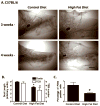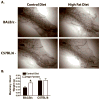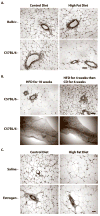Pubertal exposure to high fat diet causes mouse strain-dependent alterations in mammary gland development and estrogen responsiveness
- PMID: 20231845
- PMCID: PMC2923244
- DOI: 10.1038/ijo.2010.51
Pubertal exposure to high fat diet causes mouse strain-dependent alterations in mammary gland development and estrogen responsiveness
Abstract
Objective: Increased adolescent obesity rates in the United States are a significant public health concern. Obesity or increased adiposity during puberty in girls, an important period of breast development and a window of exposure sensitivity, may influence breast development and cancer risk. The purpose of this study was to investigate the impact of a high fat diet (HFD) on mammary gland development in obesity-susceptible C57BL/6 and obesity-resistant BALB/c mice.
Design: Pubertal or adult C57BL/6 and BALB/c mice were fed an HFD or control diet (CD) from 3 to 7 weeks of age or from 10 to 14 weeks of age, respectively. The effects of HFD diet on body weight, adiposity, mammary gland development, and mammary gland response to estrogen were evaluated.
Results: Pubertal C57BL/6 mice fed the HFD had a significant increase in body weight and adiposity, and this was accompanied by stunted mammary duct elongation and reduced mammary epithelial cell proliferation. Ovariectomy and estrogen (17-β-estradiol, E) treatment of pubertal HFD-fed C57BL/6 mice showed decreased mammary gland stimulation by E. Amphiregulin, a downstream mediator of pubertal E action, was reduced in mammary glands of HFD-fed C57BL/6 mice. Weight loss and reduced adiposity initiated by switching C57BL/6 mice from HFD to CD restored ductal elongation. Pubertal BALB/c mice fed the HFD did not exhibit a significant increase in body weight or adiposity; HFD caused increased mammary epithelial cell proliferation and had no effect on response to E. HFD had no effect on body weight or the mammary glands of adult mice.
Conclusions: HFD during puberty had a profound strain-specific effect on murine mammary gland development. Obesity and increased adiposity were associated with reduced responsiveness to estrogen and stunted ductal growth. Importantly, the effect of diet and adiposity on the mammary gland was specific to the pubertal period of development.
Conflict of interest statement
Figures







Similar articles
-
Puberty-specific promotion of mammary tumorigenesis by a high animal fat diet.Breast Cancer Res. 2015 Nov 2;17(1):138. doi: 10.1186/s13058-015-0646-4. Breast Cancer Res. 2015. PMID: 26526858 Free PMC article.
-
Peripubertal high-fat diet promotes c-Myc stabilization in mammary gland epithelium.Cancer Sci. 2020 Jul;111(7):2336-2348. doi: 10.1111/cas.14492. Epub 2020 Jun 29. Cancer Sci. 2020. PMID: 32437590 Free PMC article.
-
High-Fat Diet Alters Circadian Rhythms in Mammary Glands of Pubertal Mice.Front Endocrinol (Lausanne). 2020 Jun 18;11:349. doi: 10.3389/fendo.2020.00349. eCollection 2020. Front Endocrinol (Lausanne). 2020. PMID: 32625167 Free PMC article.
-
Amphiregulin: role in mammary gland development and breast cancer.J Mammary Gland Biol Neoplasia. 2008 Jun;13(2):159-69. doi: 10.1007/s10911-008-9075-7. Epub 2008 Apr 9. J Mammary Gland Biol Neoplasia. 2008. PMID: 18398673 Review.
-
Molecular regulators of pubertal mammary gland development.Ann Med. 2011 May;43(3):212-34. doi: 10.3109/07853890.2011.554425. Epub 2011 Mar 20. Ann Med. 2011. PMID: 21417804 Review.
Cited by
-
The role of obesity and bariatric surgery-induced weight loss in breast cancer.Cancer Metastasis Rev. 2022 Sep;41(3):673-695. doi: 10.1007/s10555-022-10050-6. Epub 2022 Jul 23. Cancer Metastasis Rev. 2022. PMID: 35870055 Free PMC article. Review.
-
Benzophenone-3 promotion of mammary tumorigenesis is diet-dependent.Oncotarget. 2020 Dec 1;11(48):4465-4478. doi: 10.18632/oncotarget.27831. eCollection 2020 Dec 1. Oncotarget. 2020. PMID: 33400736 Free PMC article.
-
Dietary Fat Intake During Adolescence and Breast Density Among Young Women.Cancer Epidemiol Biomarkers Prev. 2016 Jun;25(6):918-26. doi: 10.1158/1055-9965.EPI-15-1146. Epub 2016 May 19. Cancer Epidemiol Biomarkers Prev. 2016. PMID: 27197283 Free PMC article.
-
Nutritional Regulation of Mammary Tumor Microenvironment.Front Cell Dev Biol. 2022 Feb 2;10:803280. doi: 10.3389/fcell.2022.803280. eCollection 2022. Front Cell Dev Biol. 2022. PMID: 35186923 Free PMC article. Review.
-
Oleic acid stimulates HC11 mammary epithelial cells proliferation and mammary gland development in peripubertal mice through activation of CD36-Ca2+ and PI3K/Akt signaling pathway.Oncotarget. 2018 Jan 12;9(16):12982-12994. doi: 10.18632/oncotarget.24204. eCollection 2018 Feb 27. Oncotarget. 2018. PMID: 29560125 Free PMC article.
References
-
- Rosenfield RL, Lipton RB, Drum ML. Thelarche, pubarche, and menarche attainment in children with normal and elevated body mass index. Pediatrics. 2009;123:84–88. - PubMed
-
- Marchand L, Kolonel LN, Earle ME, Mi MP. Body size at different periods of life and breast cancer risk. Am J Epidemiol. 1988;128:137–152. - PubMed
-
- Magnusson C, Baron J, Persson I, Wolk A, Bergstrom R, Trichopoulos D, et al. Body size in different periods of life and breast cancer risk in post-menopausal women. Int J Cancer. 1998;76:29–34. - PubMed
-
- Berkey CS, Frazier AL, Gardner JD, Colditz GA. Adolescence and breast carcinoma risk. Cancer. 1999;85:2400–2409. - PubMed
Publication types
MeSH terms
Substances
Grants and funding
LinkOut - more resources
Full Text Sources
Medical

